Testimony of remote times, to be removed from the danger of a pressing threat of cultural homologation and to be delivered intact to future generations, since it is inscribed in the very history of the city. The festive universe of Milazzo is conspicuous, jealously guarded with stubborn pride and pointedly recalled, not only as an occasion for religious aggregation, but also for socialization, as well as essential complement to the poorest economic activities.
Religious celebrations
The true, more authentic soul of Milazzo and its people, is manifested especially in religious festivals, multiform expressions of that ancient and varied heritage the island’s popular culture here, more than elsewhere, strongly settled in collective life. These are celebrations that characterize the community, marked by strong ritual signs, able to communicate authentic feelings of faith and devotion, which still today constitute privileged places of memory and, therefore, a valuable opportunity to recover the collective identity.
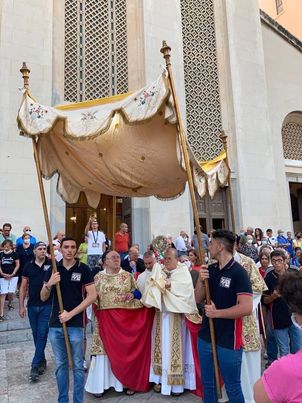
Mamertine popular devotion is poured especially on the patron saint, Santo Stefano, celebrated the first Sunday of September with a solemn and suggestive processional parade that winds through the streets of the city, Transforming alleys and squares into an immense natural theater where people are both protagonists and spectators. The court moves from the Cathedral following a precise itinerary, the way of the procession, almost a prominence that allowed in the past, and perhaps even today, the various social components on the one hand to pay tribute to the Saint and on the other to self-present annually on the city stage. The blessing of the relic concludes the procession. A choral participation characterizes the feast of the patron saint San Francesco di Paola. The rite is renewed every year on the first Sunday of May with a suggestive procession that brings together a multitude of devotees from all over the island.
From the church dedicated to the Saint, placed on the hill of San Biagio, the rod with the sacred image is carried on its shoulders by a group of bearers who compete for the privilege of supporting the weight of the simulacrum, through the streets of the city and up, for the steep climb, to the castle, followed by a rippling tide of worshippers. The procession lasts six hours and the route is the longest of any other processional parade. This is a way in which the devotees express their attachment to Saint Francis, imagined more man than holy, To the point of forming a direct and privileged relationship between the protector in need of help and the protector to whom prodigious help is invoked at a time of existential precariousness.
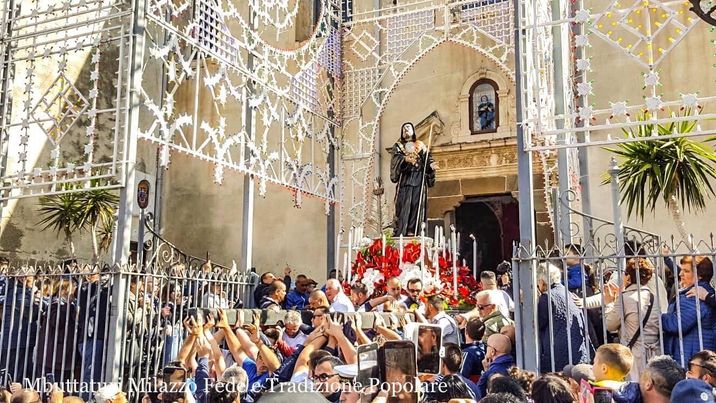
As the procession passes through the simulacrum, it grows ever more dense until reaching the port’s top, in front of the sea where, greeted by the shrill sound of the sirens on board dozens and dozens of boats, Fercolo is taking a ferry to symbolically commemorate the miraculous crossing of the Strait of Messina. Finally, the return to the Sanctuary in an atmosphere of great excitement and suggestion. The procession is proposed as an original and characteristic festive ceremony that serves to sacralize places and to exalt the deep popular faith. According to tradition, Saint Francis arrived in Milazzo in 1464, stopping for a few years. During his stay he is said to have performed many miracles. One, in particular, is remembered by popular devotion: the crossing of the Strait of Messina on foot, after a bargeuse refused to take him from one shore to another. To precede the real feast is the rite of the “thirteen Friday”, it says, instituted by Saint Francis himself to remember the twelve Apostles and the Crucifix. For thirteen consecutive Fridays the Shrine of Saint Francis is destination of the moving pilgrimage of those who have to ask the benevolence of the Holy.
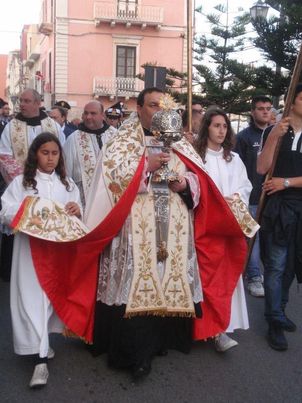
The rite of “berrettella”, the most felt moment of the entire festive cycle, always linked to the celebration of San Francesco, is in calendar on Tuesday after the feast, where the sacred intertwines with the profane without well-defined limits. It is a rite in the rite, which recalls the most remote popular customs to transfer on objects belonging to saints the thaumaturgical power attributed to the Saints themselves. The berrettella in fact, is nothing more than the headdress that San Francesco used to wear. The relic is carried in procession through the city, to the port and even, embarked on a fishing boat, is followed by a colorful procession of boats in suggestive procession on the sea. The general excitement is contributed by the complex of the many sounds that characterize the processional parade, from the music of the band to the cheers of jubilation of the people.
The tip of Luigi Rizzo is doubled, all boats stop in the beautiful scenery of the Gulf of Milazzo while a young man recites the prayer of sailors and a laurel wreath, prepared by the tertiary of San Francesco, is thrown into the water to remember the fallen. Brought back to earth , the relic in solemn procession will return to the Sanctuary.
The sea is the symbolic element that accompanies another festival particularly felt in the community of Milazzo: Our Lady of the Rosary, on October 13. The fercolo is carried in procession through the city and to the port where, with the blessing of the sacred wood of the cross, the benevolence of Our Lady is invoked on the seafarers. The procession continues to the Church of Santa Maria Maggiore, where another blessing will be given, to conclude at the Church of the Rosary.
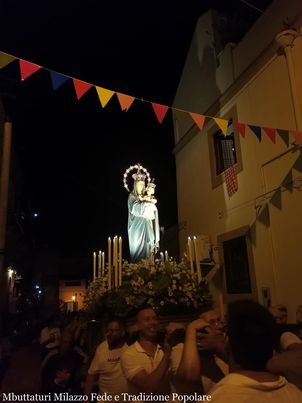
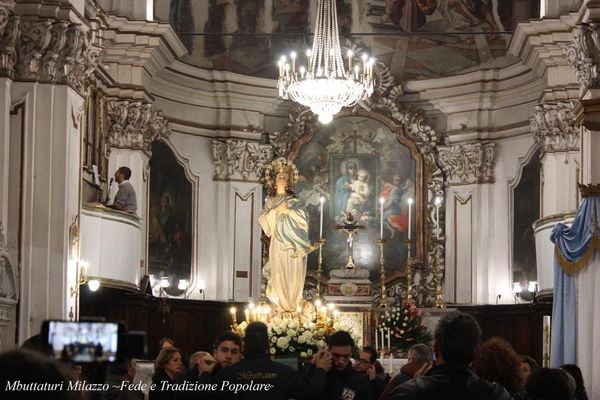
Another festival is the celebration of Our Lady of the Resurrection, on Easter Monday, which has its main theater in the Church of the Carmine. A close devotional bond unites the Madonna with the homonymous confraternity, also called “Company of good death”, established since the seventeenth century with the humanitarian purpose of offering help and assistance to prisoners, suffering and dying. And precisely for these gestures of human compassion, the Madonna to whom confreres are devoted is called the Pietà.
Of great interest is also the feast of the Holy Crucifix, on the Tuesday after Easter. Linked to the community of San Papino, the celebration is now confined in the parish, while in the past the sacred image of Christ on the cross, depicted in the beautiful masterpiece of Frate Umile da Petralia, was led in solemn procession throughout the city. The rite, through a suggestive reenactment, wants to remember the cry of the Crucifix that put an end to a long famine, miracle recorded by the chroniclers of the late eighteenth century. Due to its universal values, Easter remains the most symbolic holiday, without any temporal setting.
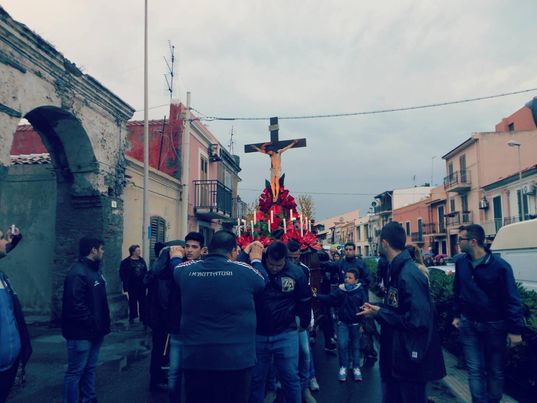
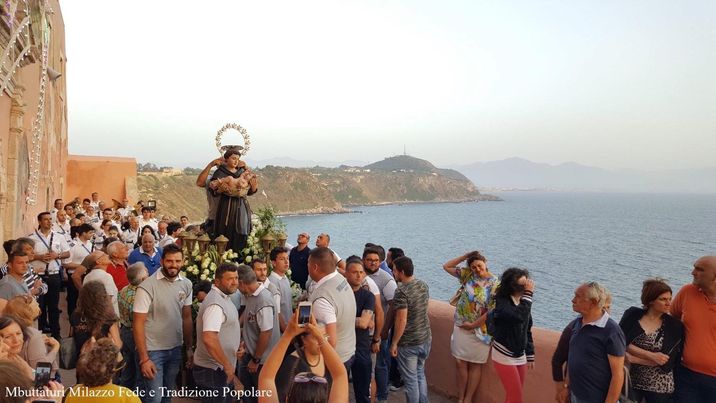
A moving pilgrimage to Capo Milazzo, where the church of Sant’Antonio is located, characterizes the feast of the Saint, on June 13. Thousands of faithful from all over Sicily converge in the original church carved entirely into the rock, to ask for the protection of the Saint. According to tradition, the cave, which later became a place of worship, hosted in 1221 Saint Anthony, shipwreck during the trip that was to take him back to Lisbon where he was born, and from where, a few years before, he had left for missionary. After his death, the cave became one of the most sacred places for the Milazzesi who in that unexpected stop showed a special benevolence of the saint towards their land.
Many other minor festivals, but no less felt, characterize the festive universe of Milazzo and attest to the great richness of local culture. Rites that, while retaining their identity have a script almost identical: the worship of the simulacrum in the church, the processional parade that reflects the hierarchical structure of the community, the crowd of faithful, the presence of bands, liturgical celebration, The fireworks display. On the second Sunday in September, in the hamlet of Tono, following the footsteps of nearby Tindari, the citizens celebrate the Black Madonna with a solemn procession. To introduce the tradition in the thirties were the last descendants of the “rais” of the tonnara del Tono, once one of the most important of Sicily.
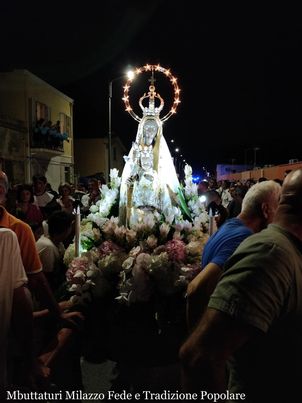
The distribution of the Benedictine bread of “San Brasi” is a typical custom for the feast of San Biagio, protector of the gorge. The offering of bread, for the sacredness that the food covers is the central moment of religious celebration that takes place in each parish, on 3 February, involving the whole city.
Twenty-one days after Easter, far from the canonical celebration, is celebrated Saint Joseph. The procession with fercolo moves from the homonymous church to the city streets with a large crowd of devotees.

On the Sunday following 16 July, a procession is led through the city to the statue of Our Lady of the Carmel.
A curious practice accompanies the celebration of Saint Rita from Cascia, on May 22. Many devotees dry the roses blessed in church by attributing to the flower, dear to the Saint, healing powers. The eighth Sunday of Easter in the church of Capo Milazzo is celebrated the feast of the Holy Trinity. Another choral moment, finally, is represented by the Corpus Christi, celebrated with a solemn procession to which children who have received their first communion participate.